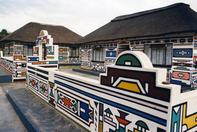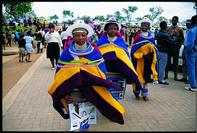Best Known for Art

The Ndzundza Ndebele are best known for their art. Similar motifs, designs and colours are used in mural decoration - done by the women - and beadwork. Patterns embrace a variety of forms and symbols: elaborate use is made of geometric shapes, and natural objects such as flowers, snakes, birds and small animals. In modern times, letters of the buildings, windmills and aeroplanes are used. The early Ndebele relied on natural pigments - soot, ash and clay - for the colours in their decorations.
With the arrival of white traders, however, they had access to a wide range of coloured paints, which are extensively used today. Traditionally, women devoted their time to mural art in the late autumn and winter months, when the planting, weeding and harvesting of sorghum and maize crops were completed, and they had a reasonable amount of leisure time.
This is also the time of the year when they did most of their beadwork, sitting together in their courtyards of their homes, enjoying the camaraderie of other women in the homestead and the mellow warmth of the winter sun. Beadwork, however, was not exclusively a winter activity, as it was also done during free moments in summer and spring.
Range of Ornaments Worn

It is a moot point whether the elaborate personal adornment worn by Ndebele women owes more to their own aesthetic sensibilities or to the wishes of Ndebele men to have their status as wealthy husbands displayed by their wives' ornamentation. The range of ornaments worn, which become increasingly spectacular after marriage and with age, probably greater than that of any other grouping.
The iirholwana, beaded wire hoops of various sizes which are worn by women around their wrists, arms, ankles, legs, neck and stomach, are probably the most popular. In earlier times, once her home was built, and Ndebele wife would also wear copper or brass rings 'iindzila' around her neck.
These are believed to have strong ritual powers, although wearing them on a permanent basis is no longer common practice. Often, an older woman who wears these rings will have them removed on a visit to the hospital, after which they will not be replaced. Traditionally the husband provided his wife with her iindzila; the more rings she wore, the greater was her husband's wealth reputed to be. lindzila are considered by a wife to be a token of her bond with and faithfulness to her husband.
Only on his death would she remove them. Among both the Manala and Ndzundza, girls wear ornaments from early childhood. These comprise beaded anklets, wristlets and necklaces. At this age, they traditionally wear loin coverings 'iinrhabi', little cascades of leather thongs attached to waist-straps and tipped with beads, which cover the upper part of the thighs.
In adolescence, instead of the iinrhabi, the isiphephetu is worn, a small, rectangular and stiffly beaded fore-apron. After marriage, this is replaced with the umaphotho, a large, goatskin apron, which often reaches the ankles and is intricately decorated with white beads. On her wedding day, the bride wears a veil of threaded beads which completely hides her face.
Traditionally the colours of the beads were endowed with special significance, reflecting the stages of development in a person's life, from infancy to parenthood. The combination of colours also reflected the mood of the maker: joy, happy expectation, sorrow, or insecurity. With urbanization and modernization, this has largely disappeared. Ndebele men seldom adorn themselves, except for rituals and ceremonies, when they wear what has been given to them by their wives.